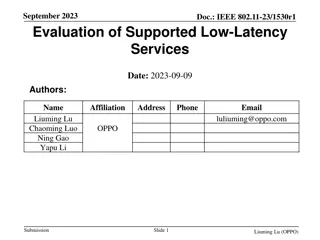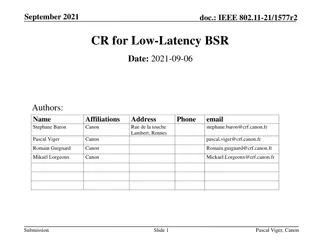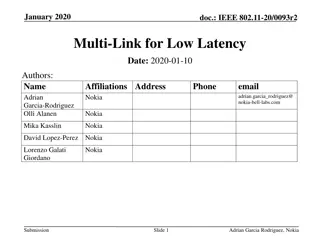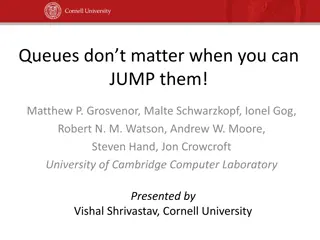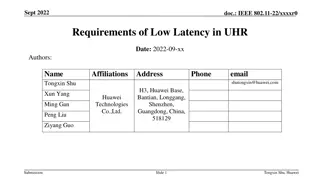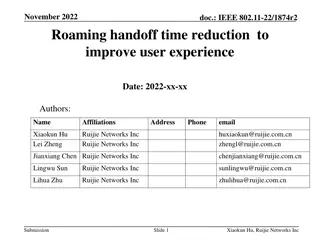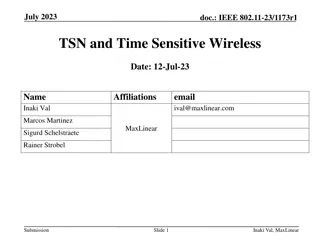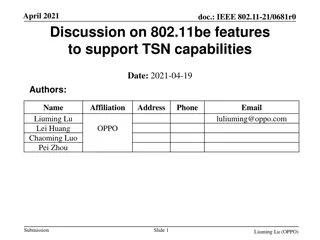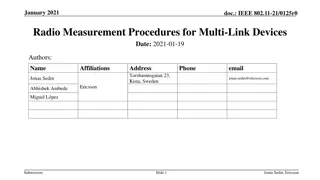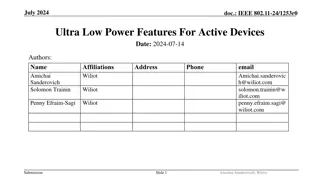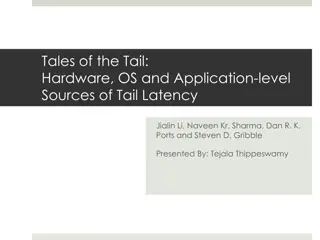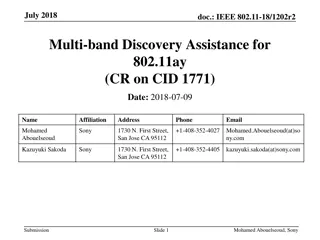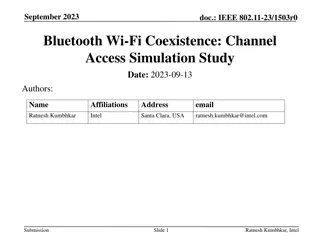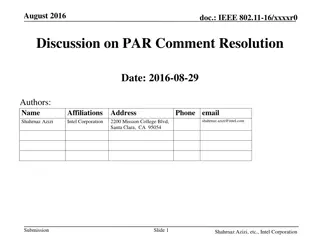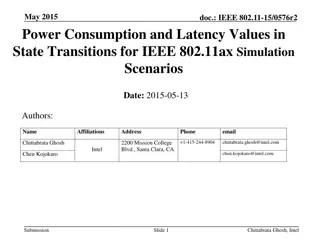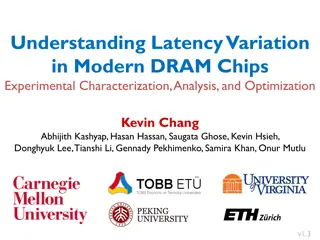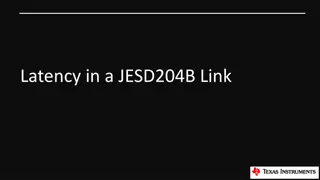Latency Measurement in IEEE 802.11 for Low Latency Applications
IEEE 802.11-20/0484r0 discusses the importance of latency measurement for low latency applications in WLAN technologies. The document emphasizes the need for improved worst-case latency and jitter, addressing interference issues to ensure guaranteed latency for scheduled transmissions. Various contributions propose enhancements in latency measurement methods, statistics, and techniques, aiming to support low-latency applications effectively within the Wi-Fi environment.
Download Presentation

Please find below an Image/Link to download the presentation.
The content on the website is provided AS IS for your information and personal use only. It may not be sold, licensed, or shared on other websites without obtaining consent from the author. Download presentation by click this link. If you encounter any issues during the download, it is possible that the publisher has removed the file from their server.
E N D
Presentation Transcript
2020 doc.: IEEE 802.11-20/0484r0 Latency Measurement for Low Latency Applications Date: 2020-03-12 Authors: Name Affiliation Address Phone Email Liuming Lu ZTE Corporation No.889 Bibo Road, Shanghai, P.R.China lu.liuming@zte.com.cn Liquan Yuan ZTE Corporation No.889 Bibo Road, Shanghai, P.R.China yuan.liquan@zte.com.cn Submission 1 Liuming Lu, etc, ZTE
2020 doc.: IEEE 802.11-20/0484r0 Introduction (1/2) TGbe aims to build on the current and emerging WLAN technologies by providing further improvement of aggregate throughput and latency. And At least one mode of operation capable of improved worst case latency and jitter will be defined.[1][2] Because Wi-Fi uses the unlicensed spectrum the interference from OBSS and other sources would usually exist, how to avoid or reduce the impact of the inference on guaranteed latency for scheduled transmission is of vital importance. Submission 2 Liuming Lu, etc, ZTE
2020 doc.: IEEE 802.11-20/0484r0 Introduction (2/2) Sufficient Latency Measurement can not only evaluate whether the current communication environment is suitable for the transmission of low latency applications, but also distinguish the different types of latency, caused by the varying interference sources. This contribution proposes to further specify the latency measurement in TGbe including the addition of latency statistics, which would help to distinguish the different types of latency. Submission 3 Liuming Lu, etc, ZTE
2020 doc.: IEEE 802.11-20/0484r0 Background (1/2) Recently for the low-latency topics of TGbe several papers mention time- aware scheduling, multi-link aggregation, latency statistics, etc. Contribution[3] has shown that time-aware scheduling operates on managed STAs, and interfering transmissions may impact the capability to guarantee bounded latency, further unmanaged STAs/OBSSs are seen as interference. Contribution[4] has presented latency gains with multi-link aggregation, showing that adding an auxiliary link significantly improves the worst-case latency. But the latency gains seem to be not enough to support the RTA, such as virtual reality or augmented reality. Contribution[5] proposes to add more latency statistics in EHT for MLO including average transmit delay and TBD percentile transmit delay statistics of each link. Submission 4 Liuming Lu, etc, ZTE
2020 doc.: IEEE 802.11-20/0484r0 Background (2/2) Time-aware scheduling theoretically seems to be a good method for low- latency, but encounters some difficulties in the Wi-Fi environment, such as the interference from unmanaged STAs/OBSSs, etc. MLO helps to improve the latency, and how to adjust the transmission on different links for low-latency applications should be based on the current load and environment on the current links, which needs the real-time measurement of their corresponding quantitative parameters. The current latency statistics seems to be not enough for latency measurement, especially to support the low-latency applications. The required additional latency statistics need further study. Submission 5 Liuming Lu, etc, ZTE
2020 doc.: IEEE 802.11-20/0484r0 Latency Analyses The time ACK for the initial transmission is received the time the frame is ready for transmission the time the MSDU is passed to the MAC The time ACK for the retransmission is received the actual frame transmission start time STA1 the actual retransmission start time the virtual demarcation point between intra- BSS waiting time and inter-BSS waiting time Frame loss the actual ACK transmission start time STA2 The time the frame for the initial transmission is received The time ACK for the retransmission is transmitted The time retransmission frame is received T1 T4 T2 T3 T5 Submission
2020 doc.: IEEE 802.11-20/0484r0 Latency Classification The classification of latency helps to analyze the current communication environment and distinguishes the principal factors which lead to the relatively large latency. AP and non-AP STAs can use the different types of latency statistics to adjust the transmission strategy, especially for MLO. Latency Description Caused by Classification T1 time interval from the time the MSDU is passed to the MAC to the time the frame is ready for transmission packet congestion BSS-Controllable T2 time interval of waiting time for intra-BSS transmission between the time the frame is ready for transmission and the actual frame transmission start time Intra-BSS transmission contention BSS-Controllable T3 time interval of waiting time for inter-BSS transmission between the time the frame is ready for transmission and the actual frame transmission start time Inter-BSS transmission contention BSS-Uncontrollable T4 time interval between the actual frame transmission start time and The time ACK for the initial transmission is received Frame size and the performance of AP and non-AP STAs BSS-Controllable T5 time interval between the actual frame transmission start time and The time ACK for the retransmission is received Outside interference BSS-Uncontrollable Submission 7 Liuming Lu, etc, ZTE
2020 doc.: IEEE 802.11-20/0484r0 Proposal Access delay defined in the current 802.11 standard doesn t differentiate the intra-BSS and inter-BSS access delay. This contribution proposes to add the following latency statistics in 802.11be, which helps to distinguish the principal factors which lead to the relatively large latency. BSS Access Delay for intra-BSS transmission: time interval of waiting time for intra-BSS transmission between the time the frame is ready for transmission and the actual frame transmission start time BSS Access Delay for inter-BSS transmission: time interval of waiting time for inter-BSS transmission between the timethe frame is ready for transmission and the actual frame transmission start time Submission 8 Liuming Lu, etc, ZTE
2020 doc.: IEEE 802.11-20/0484r0 Conclusions The classification of latency helps to analyze the current communication environment and distinguishes the principal factors which lead to the relatively large latency. This contribution proposes to add the latency statistics including BSS Access Delay for intra-BSS transmission and BSS Access Delay for inter- BSS transmission. Submission 9 Liuming Lu, etc, ZTE
2020 doc.: IEEE 802.11-20/0484r0 Appendix The related definitions of access delay in current 802.11 standard ( 802.11 2016 ) don t differentiate the intra-BSS and inter-BSS access delay, showed in the following: Access delay is measured by the AP s or PCP s MAC layer being the average medium access delay for transmitted frames measured from the time the MPDU is ready for transmission (i.e., begins CSMA/CA access or SP access, as appropriate) until the actual frame transmission start time. Access delay measurement results are included in the BSS Average Delay element and in the BSS AC Access Delay element. BSS Average Access Delay element contains the AP Average Access Delay, which is a measure of load in the BSS and is available in both QoS APs and non-QoS APs. BSS AC Access Delay element: The BSS AC Access Delay element contains an Access Category Access Delay field Submission 10 Liuming Lu, etc, ZTE
2020 doc.: IEEE 802.11-20/0484r0 Straw Poll 1 Do you support that the latency statistics including BSS Access Delay for intra-BSS transmission and BSS Access Delay for inter-BSS transmission are added in 802.11be? BSS Access Delay for intra-BSS transmission: time interval of waiting time for intra-BSS transmission between the time the frame is ready for transmission and the actual frame transmission start time BSS Access Delay for inter-BSS transmission: time interval of waiting time for inter-BSS transmission between the timethe frame is ready for transmission and the actual frame transmission start time Submission 11 Liuming Lu, etc, ZTE
2020 doc.: IEEE 802.11-20/0484r0 References 1. 11-18-1231-06-0eht-eht-draft-proposed-par, 802.11 EHT Proposed PAR 2. 11-18-1233-07-0eht-eht-draft-proposed-csd, IEEE 802.11 EHT draft Proposed CSD 3. 11-19-1933-01-00be-capabilities-to-support-time-aware-scheduling-in- 802-11be 4. 11-19-1081-01-00be-multi-link-aggregation-gain-analysis-latency,Multi- Link Aggregation: Latency Gains 5. 11-20-0105-03-00be-link-latency-statistics-of-multi-band-operations-in- eht Submission 12 Liuming Lu, etc, ZTE
2020 doc.: IEEE 802.11-20/0484r0 Thank you! Submission 13 Liuming Lu, etc, ZTE



